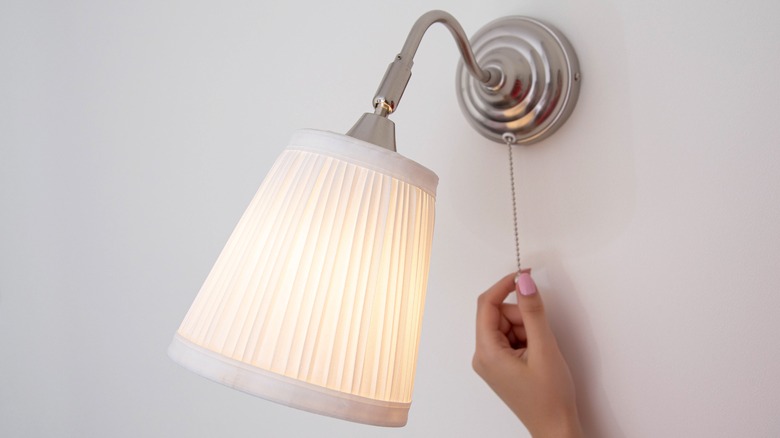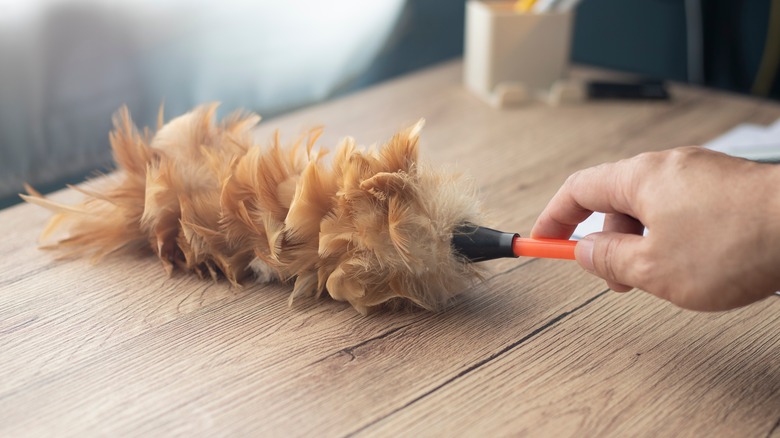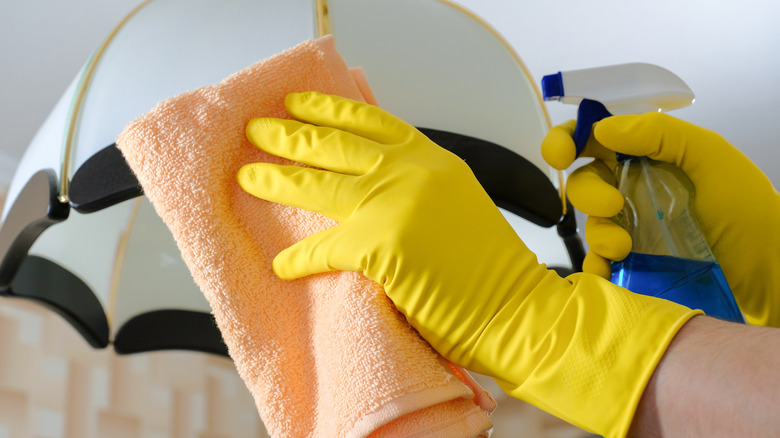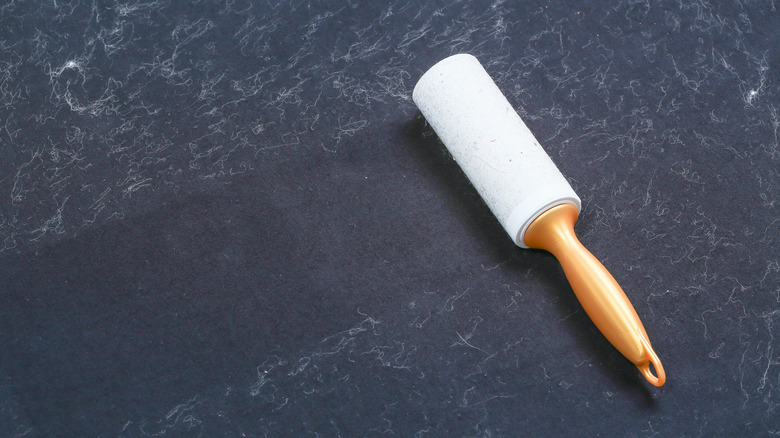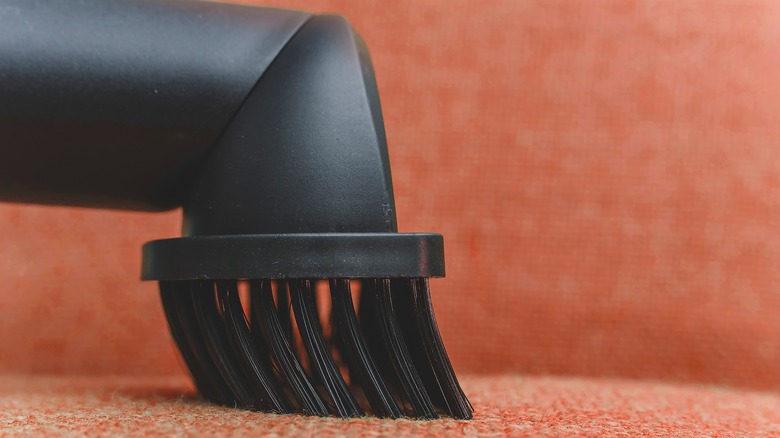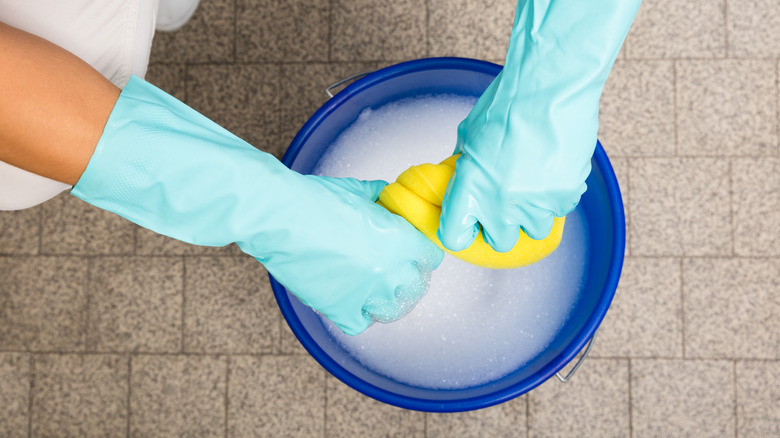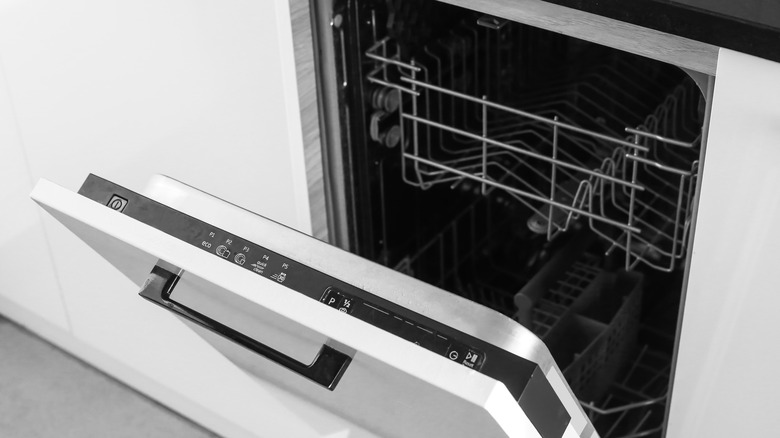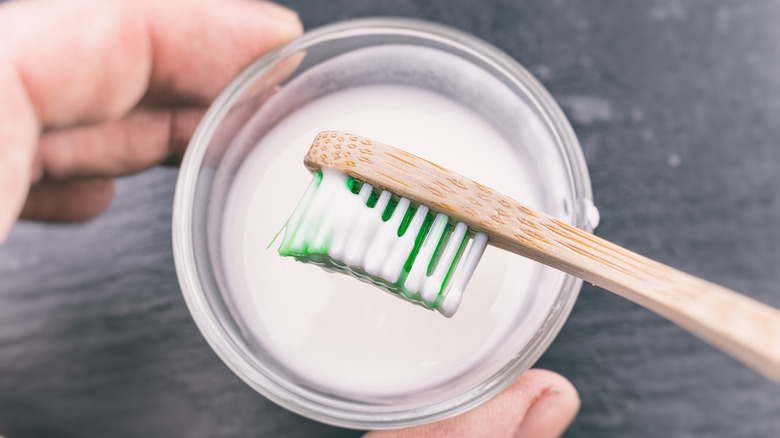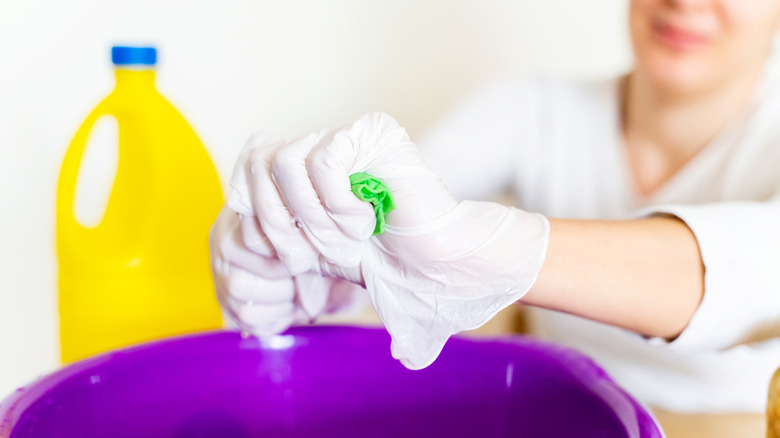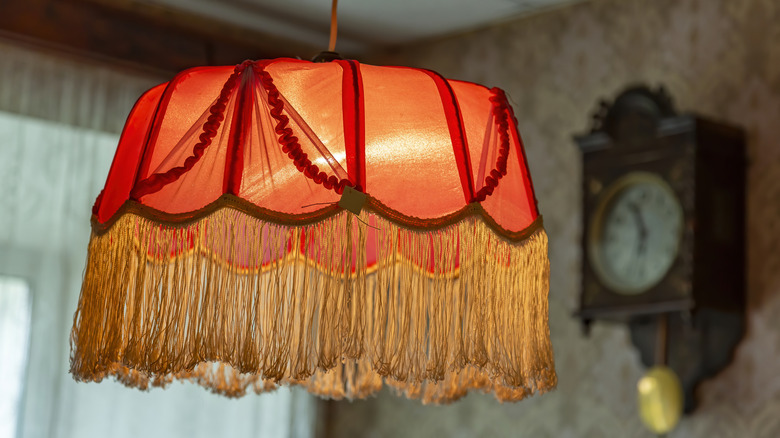How To Clean Your Lampshades
Lampshades collect dust, grime, and pet hair just like any other home surface, but they're easy to overlook when dusting your living room or bedside tables. That is until you notice that it's dusty, yellowed, or generally dingy looking. Besides keeping a clean home, it's worthwhile to clean your lampshades as part of your regular cleaning routine. Much of the yellowing that affects them over time comes from accumulated dust and dirt, and grime can contribute to allergies and respiratory ailments, per the National Center for Healthy Housing.
Lampshades come in a wide variety of materials. Options include paper, plastic, metal, glass, fabrics like cotton, silk, and linen, and other distinctive materials, like feathers, shells, or cork. They can also have embellishments like pleats, tassels, beading, and appliques. The right cleaning method depends on the lampshade's material, construction, and soil level, all of which we explore ahead. Whether your lampshades look worse for wear, or you want to ensure they never get that way, read on to learn how to clean them.
Prepare the lampshade for cleaning
Once you've found the right lampshade for a light fixture, the last thing you want to do is accidentally damage it while cleaning. Before whipping out the cleaning materials, check for maintenance instructions from the manufacturer, which may be found on a care tag or in the user guide. If the lampshade doesn't specify cleaning directions, you'll need to use your discretion, keeping its material and sturdiness in mind. In general, it's best to try a dry cleaning method first, like dusting, vacuuming, or lint rolling. Using water to clean a lampshade can run a few risks, including damaging or discoloring the material or frame.
Safety always comes first when cleaning light fixtures. Always unplug or turn off the light before cleaning. Don't attempt to clean a lampshade while the light is still hot. In fact, it's best to remove the lampshade from the fixture altogether. This gives you the best control while cleaning and ensures you won't accidentally damage the lamp itself.
Feather or microfiber duster
A feather or microfiber duster might be just the tool you need to get a lampshade nice and clean. Feather dusters have a reputation for pushing dust around instead of picking it up, but they can be beneficial for cleaning delicate lampshades. According to Think Maids, a feather duster is a good choice for dusting easily-breakable items, including some fragile paper or parchment lampshades. These dusters require very little pressure to remove dust. The feathers also get into small nooks and crannies to gently brush dust away without forcing the duster into these spaces.
For sturdier lampshades, a microfiber duster is a good choice. Since they're so gentle, dusters are suitable for pretty much every lampshade type. Remember that dusters only work on loose dust and might not cut it for caked-on grime. For harder-to-remove dirt, consider one of the cleaning methods ahead.
Microfiber cloth
An indispensable item in most cleaning arsenals, the handy microfiber cloth is a great choice for cleaning lampshades because you can use it for both dry and wet cleaning. According to Explain That Stuff, a microfiber cloth's cleaning power comes from its teeny tiny fibers, which latch onto dust and dirt better than a regular soft cloth. This dust-attracting power is excellent for cleaning any lampshade, but especially delicate ones since it requires fewer passes to pick up dust. When dusting a paper or parchment lamp, consider wearing gloves. Gloves prevent the oils from your hands from leaving marks.
For a slightly deeper but still gentle clean, use a damp microfiber cloth. Of course, water should only be used on materials that can tolerate moisture (so not on paper or silk shades). There's often no need to use soap when cleaning with a microfiber cloth, which means you don't need to rinse the lampshade after.
Lint roller
Lint rollers can do more than pick up lint off your favorite jacket; you can also use them to remove dust on lampshades. A lint roller is excellent for picking up bits and pieces that a duster or microfiber cloth can leave behind, such as stubborn pet hair. It also prevents it from going airborne since the sticky tape traps it upon contact. If you're worried about the lint roller initially being too sticky or leaving residue behind, run it over another surface to remove some of the tack before using it on the lampshade.
However, lint rollers are only suitable for sturdier shades, like those made from tougher fabrics like cotton or linen. Avoid using them on fragile fabrics, paper, or parchment, since these materials can get stuck to the rollers and tear. If you're unsure if the fabric is strong enough, it's better to use caution and use a duster instead.
Vacuum cleaner
A vacuum cleaner is suitable for cleaning pretty much any sturdy lampshade material, hard or soft. It's especially a good choice for fluffy lampshades, like statement shades made with feathers, tassels, or fluffy fabrics. Just make sure to consider suction strength to ensure the lampshade doesn't get damaged. If the vacuum cleaner has adjustable suction, start at the lowest setting.
Vacuums often come with a kit of attachments, and each one is designed to tackle a specific job. To start, use the soft brush attachment to lift stuck-on dust. It is suitable for most lampshades since it picks up particles without scratching the surface, per Clean Mama. However, the upholstery tool can make the job go by faster for large and durable fabric lampshades. Lampshades can have small nooks and crannies around the shade and frame. Use the crevice tool to clear debris from these hard-to-reach spots.
Water and mild detergent
Cleaning with water and soap is an effective way to tidy up some lampshades. This method is great for non-porous materials, as well as sturdier fabrics. Before cleaning with water, examine the lampshade to determine if it's glued together. If it looks like some parts are glued, it's best to avoid immersing the shade in water so the glue doesn't break down. However, HomeSteady notes that fixing any mishaps with fabric adhesive is possible. It's harder to repair color damage, however, so test the color fastness of the shade before washing it. You can do so by rubbing water and soap in an inconspicuous area.
To wash a lampshade, use a few drops of dish soap or laundry detergent in warm water. Take care not to make it too soapy since it just means there's more residue to rinse out. Depending on the fabric and soil level, you can use the soapy water to spot-clean the shade or immerse it completely for an all-over clean. Use a soft cloth, soft-bristled brush, or toothbrush to agitate dust out of the fabric. After cleaning, remove soap residue by rinsing the lampshade or dabbing at it with a clean, wet cloth. Once finished, dry the shade quickly and thoroughly by placing it in the sun or front of a fan. This step can help prevent metal frame parts from rusting or mildew setting into the fabric.
Dishwasher
Another surprising way to clean some sturdy lampshades is by running them through the dishwasher. This method is only suitable for the sturdiest of lampshades, and they need to be small enough to fit on the top rack, as per Winnipeg Free Press. Generally, dishwasher cleaning is only suitable for simple plastic or glass shades. Avoid this method if you have shades with ornate embellishments since they can dislodge during a washing cycle. You should also check the lampshade for glued parts since the water and heat in the dishwasher may deteriorate some adhesives.
If the lampshade is safe to wash in the dishwasher, consider using vinegar instead of detergent. Bleaching ingredients in some detergents run the risk of discoloring the piece. Lastly, consider taking the lampshade out before the high-heat drying cycle. They aren't designed to tolerate this extreme heat like dishes are, so you're better off taking them out to air dry.
Cleaning yellowed spots and stains
A lampshade with yellow spots or stains still won't look its best, even after dusting and washing. Years of neglect and accidental spills can leave a lampshade discolored. If the other methods on this list didn't do the trick, consider scrubbing leftover spots with a baking soda paste. This method is suitable for fabric shades that are safe to clean with water.
There are a couple of baking soda recipes that can help absorb and lift stains, according to the Grove. The simplest is a paste made of baking soda and a little bit of water. For a cleaning boost, mix baking soda with hydrogen peroxide instead (though keep in mind that hydrogen peroxide can bleach fabrics, so you'll want to do a color fastness test first). With either mixture type, slather the paste on the yellowed area or stain it and leave it to dry. Then brush it off with a dry brush, but a soft cloth or toothbrush can be used to maximize scrubbing power. Sometimes, baking soda can leave a white stain behind. Don't fret — this is usually just a sign of leftover residue and is simple to clean away with a wet cloth.
Removing mold and mildew
Lampshades can fall victim to mold and mildew in damp conditions, which isn't only unsightly, but can be detrimental to your health. Small patches of mold or mildew can be cleaned up using a diluted bleach or vinegar solution. Just be sure not to mix bleach and vinegar. Choose one or the other since combining the two can release harmful chlorine gas (per the Missouri Poison Center).
Cleaning with bleach or vinegar is suitable for non-porous materials and sturdier fabrics. When using these cleaners on cloth, it's a good idea to check the color fastness on an inconspicuous area before going ahead. Clorox recommends a solution of ¼ cup of bleach to 1 gallon of water to clean mold or mildew spots. If you're worried about accidentally bleaching the fabric, vinegar is a gentler alternative. According to the Oregon State University Extension, a 1:1 mixture of vinegar and water is enough to kill mold. However, just saturating the area isn't enough. With either method, the mold or mildew spots should be scrubbed away with a toothbrush, soft brush, or a cloth to ensure it is properly removed.
Getting rid of smells
Whether you picked up a one-of-a-kind lampshade in a thrift store or inherited a keepsake from a family member, there's no way around it — some lampshades are a little smelly. When it comes to vintage finds, too much cleaning and scrubbing can cause damage, so consider an alternative method to banish smells.
The American Library Association recommends harnessing the power of baking soda. Rather than sprinkling the powder directly onto the fabric, place the lampshade and a few bowls of baking soda in a container with a lid. It may take a few days or weeks to absorb the smell, but this is a no-mess and no-damage solution. This method is safe for all types of shades, even delicate options. If the baking soda isn't cutting it, The New York Times recommends a more non-traditional solution. If you have a sturdy lampshade, you can cover it with active charcoal cat litter or loose active charcoal. It is an excellent odor absorber and can help reduce musty smells.

